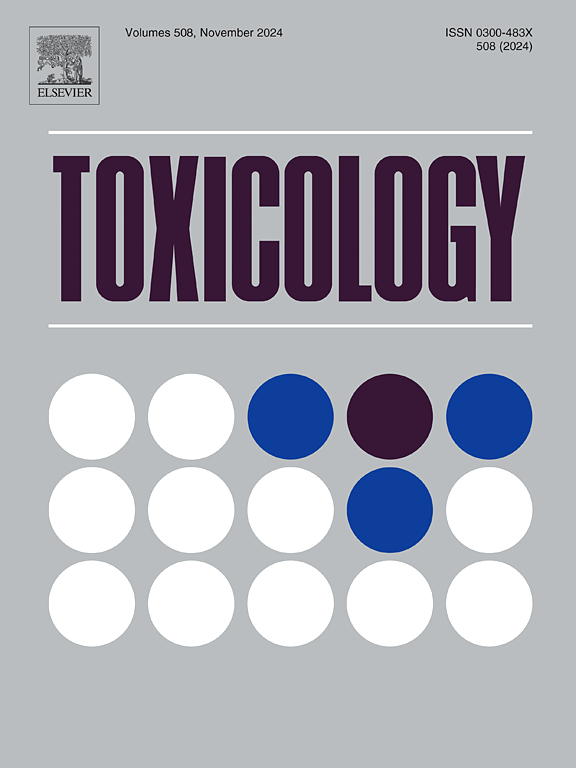EGFR和CYP信号中断是6ppd -醌肝毒性的基础:来自网络和机器学习方法的见解
IF 4.6
3区 医学
Q1 PHARMACOLOGY & PHARMACY
引用次数: 0
摘要
N-(1,3-二甲基丁基)-N ' -苯基-对苯二胺醌(6PPD-醌)是一种新兴的环境污染物,来源于常见的轮胎添加剂6PPD,已在人体生物样品中检测到令人震惊的结果,并与肝损伤有关。然而,驱动其肝毒性的潜在分子机制在很大程度上仍未被探索。我们采用集成的芯片策略,包括ADMET分析、网络毒理学分析、分子对接、分子动力学(MD)模拟和机器学习(ML)来揭示6ppd -醌的肝毒性机制。我们的分析确定了6ppd -醌靶点与肝毒性相关基因之间的62个关键交叉基因。蛋白-蛋白相互作用分析揭示了两个不同的功能模块:表皮生长因子受体(EGFR)介导的信号通路和细胞色素P450 (CYP)酶驱动的代谢过程。分子对接和MD模拟证实了6ppd -醌与EGFR之间非常强而稳定的结合相互作用。先进的ML模型进一步将6ppd -醌分类为有效的EGFR抑制剂,验证精度为0.90,f1评分为0.90。综合ADMET和对接分析还表明具有多cyp酶抑制能力。总之,我们的研究结果表明,6ppd -醌通过EGFR信号抑制和cypp介导的代谢破坏双重机制诱导肝损伤。这项工作为评估轮胎来源的环境污染物的肝毒性风险提供了一个关键的机制框架,并强调了减轻其不利健康影响的潜在干预目标。本文章由计算机程序翻译,如有差异,请以英文原文为准。
EGFR and CYP signaling disruption underlies 6PPD-quinone hepatotoxicity: Insights from a network and machine learning approach
N-(1,3-dimethylbutyl)-N′-phenyl-p-phenylenediamine quinone (6PPD-quinone), an emerging environmental contaminant derived from the common tire additive 6PPD, has been alarmingly detected in human biology samples and is associated with liver injury. However, the underlying molecular mechanisms driving its hepatotoxicity remain largely unexplored. We employed an integrated in silico strategy encompassing ADMET profiling, network toxicology analysis, molecular docking, molecular dynamics (MD) simulations, and machine learning (ML) to uncover the hepatotoxic mechanisms of 6PPD-quinone. Our analysis identified 62 critical intersection genes between 6PPD-quinone targets and hepatotoxicity-related genes. Protein-protein interaction analysis revealed two distinct functional modules: Epidermal Growth Factor Receptor (EGFR)-mediated signaling pathways and Cytochrome P450 (CYP) enzyme-driven metabolic processes. Molecular docking and MD simulations confirmed remarkably strong and stable binding interactions between 6PPD-quinone and EGFR. An advanced ML model further classified 6PPD-quinone as a potent EGFR inhibitor, achieving a validation accuracy of 0.90 and an F1-score of 0.90. Comprehensive ADMET and docking analyses additionally indicated multi-CYP enzyme inhibition capabilities. In conclusion, our findings suggest that 6PPD-quinone induces liver injury through a dual mechanism involving EGFR signaling suppression and CYP-mediated metabolic disruption. This work provides a critical mechanistic framework for assessing the hepatotoxic risks of tire-derived environmental pollutants and highlights potential intervention targets for mitigating their adverse health effects.
求助全文
通过发布文献求助,成功后即可免费获取论文全文。
去求助
来源期刊

Toxicology
医学-毒理学
CiteScore
7.80
自引率
4.40%
发文量
222
审稿时长
23 days
期刊介绍:
Toxicology is an international, peer-reviewed journal that publishes only the highest quality original scientific research and critical reviews describing hypothesis-based investigations into mechanisms of toxicity associated with exposures to xenobiotic chemicals, particularly as it relates to human health. In this respect "mechanisms" is defined on both the macro (e.g. physiological, biological, kinetic, species, sex, etc.) and molecular (genomic, transcriptomic, metabolic, etc.) scale. Emphasis is placed on findings that identify novel hazards and that can be extrapolated to exposures and mechanisms that are relevant to estimating human risk. Toxicology also publishes brief communications, personal commentaries and opinion articles, as well as concise expert reviews on contemporary topics. All research and review articles published in Toxicology are subject to rigorous peer review. Authors are asked to contact the Editor-in-Chief prior to submitting review articles or commentaries for consideration for publication in Toxicology.
 求助内容:
求助内容: 应助结果提醒方式:
应助结果提醒方式:


